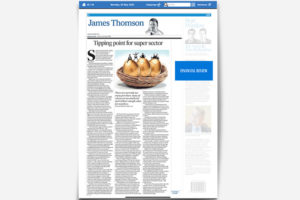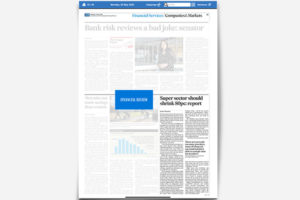MEDIA RELEASE: Australia’s superannuation system needs further consolidation to survive and thrive in the post-COVID-19 world
Monday 25 May 2020
MEDIA RELEASE
Australia’s superannuation system needs further consolidation to survive and thrive in the post-COVID-19 world
- COVID-19 shocks will help drive consolidation of the superannuation system, including the impact of cash-flow reduction from the early release of superannuation measures
- Superannuation system needs to quickly consolidate to become more efficient and reduce costs for members
- Members could be $45,000 better off at retirement age if the system is restructured to comprise of a small number of efficient, high performing funds
- Optimum number of funds in Australia likely to be around 15, from 92 currently
- Super funds should have a minimum number of 500,000 members to survive in the long-term to perform at their best and reduce costs
A new report by management consulting firm Right Lane has identified the urgent need for higher-cost superannuation funds to merge or face the consequences as cashflows as well as asset values fall, in large part due to the impact of COVID-19.
The 2020 Industry Super Forces at Work report, the eighth annual report produced by Right Lane on the state of the industry, outlines that the superannuation system has now reached a tipping point when smaller funds need to accelerate plans to merge or face the prospect of extinction as growth becomes more difficult and members continue to switch into larger funds.
The report has identified that the optimal number of super funds in Australia is around 15, compared to the 92 that currently operate, based on data showing the long-term trends in cost efficiency, fund growth and investment returns.
Right Lane’s 2020 Industry Super Forces at Work report concluded: ‘An idealised structure for the superannuation system would have 3-5 generalist mega-funds and 7-10 specialised funds, with no fewer than 500,000 members. Under this system, those who currently join an average sub-scale fund at the start of their working lives could be $45,000 better off by the time they retire.’
The report found that size matters when it comes to cost efficiency and returns, meaning the smaller funds must merge or face the possibility of declining competitiveness and eventual extinction.
‘Size matters for costs – at a system level, the largest funds are generally the cheapest and our research on long-run average costs shows that funds with fewer than 500,000 members are generally not efficient. Costs impact retirement incomes significantly – while investment returns come and go, costs stay forever,’ the report said.
‘The Australian superannuation system must become more efficient. There are currently too many providers, many of whom are too small and don’t deliver enough value for members,’ said Abhishek Chhikara, an associate principal at Right Lane.
‘At a sector level, industry funds have outperformed retail funds on growth and efficiency. Seven out of the top ten fastest-growing funds are industry funds, and the median operating cost for an industry fund is approximately half of the median cost for a retail fund,’ said Chhikara.
‘While industry funds have consistently delivered better net returns for members, more than half of them are facing headwinds when it comes to their economics. 19 out of the 34 remaining industry funds have been growing total costs while member numbers have decreased. As inflows dry up, accounts consolidate and returns go negative, many of these funds also risk a cash crunch, making it harder for them to remain competitive,’ said Chhikara.
‘There has been some change in the system with the bigger funds getting bigger, leaving behind the smaller funds, who cannot compete on efficiency and returns. These small funds must find a big brother or sister to merge with as soon as possible,’ said Chhikara.
‘The pressure on these smaller funds will continue to grow. Best in show is already here, with a handful of funds capturing nearly all of the net member switching flows in the system; that is, members that switch their funds. In 2014, the largest industry funds were capturing a modest amount in net member switching flows. Today, this number has grown to an extraordinary $19bn,’ said Chhikara.
‘Getting to an “idealised” structure of fewer funds in Australia will not be easy. The impact of COVID-19, in addition to account consolidation, the protecting your super package and other pressures, will accelerate the challenges for some funds, especially as billions of dollars have already been withdrawn as part of the Federal Government’s measures to deal with the coronavirus crisis. As unemployment inevitably grows in the months to come, that will have an additional negative impact on funds and their cashflows. All these forces combined means the superannuation industry needs to act now,’ said Chhikara.
About Right Lane
Right Lane was established in 1997 to help private, not for profit and public sector clients to accelerate their growth plans. The firm has a particular specialisation in the superannuation industry, advising several funds and their service providers. In 2015, Right Lane became Australia’s first B Corp certified strategy consulting firm. This follows Right Lane’s decision in 2011 to adopt ‘for benefit’ principles across the firm, including reasonable returns, inclusive ownership, stakeholder governance, transparency, and social and environmental responsibility.
For more information or a copy of a selection of pages from the subscriber-only 2020 Industry Super Forces at Work report please contact Abhishek Chhikara at abhishek.chhikara@rightlane.com.au or Stephen Dabkowski at steve@bluedot.net.au.
COVID-19 tipping point for bloated super sector
Analysis of Australia’s super sector suggests the pandemic will exacerbate pressure building on funds and could force consolidation that leave as few as 10 funds.
Super sector should shrink by 80 per cent: report
The pressures on fees and costs exacerbated by COVID-19 should drive a wave of consolidation in the superannuation sector, with the ideal structure of the industry built on about 15 funds, down from the existing 92.
If you would like further information on the topics discussed above, please contact Abhishek Chhikara at abhishek.chhikara@rightlane.com.au or contact Right Lane Consulting through the form below.


